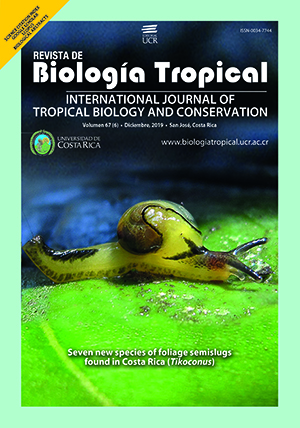Resumen
American crocodile (Crocodylus acutus)(Reptilia:Crocodilidae) and caiman (Caiman crocodilus)(Reptilia:Alligatoridae) population status, in the Costarican Central Caribbean. Two species of crocodilians have been described in Costa Rica, american crocodile (Crocodylus acutus: Cuvier 1807), and caiman (Caiman crocodilus: Linnaeus 1758). In Costa Rica, data has been generated on both species, but populations in the Pacific have received more attention from researchers; due to the fact that the Pacific slope has a greater development, which brings greater social pressure on the attention of the incidents generated by the encounter between humans and crocodiles. This study, performed during 2017, was done in an area of approximately 400 km2, characterized by having a wide and dense network of water courses, which includes the Matina, Pacuare, Reventazón and Parismina rivers. In these rivers, an average of 25 kilometers were traveled from the coastline up stream to the interior of the territory, including the Tortuguero canals, and other water bodies that connect these rivers, as well as in the most important lagoons and secondary channels. Three repetitions were made per segment. A population of 1084 caimans and 503 crocodiles is estimated; for a relative abundance of 8.64 and 2.80 ind/Km respectively. Speaking of caimans, up to 12% of individuals of reproductive age were observed, while for crocodiles that number was only 2%. The presence of both species in the different places studied, turned out to be significantly different for crocodiles and for caimans (Kruskal-Wallis, p≤0,000). Likewise, the size distribution is similar for crocodiles reported in all environments (Kruskal-Wallis, p≤0.15), while for caimans it indicates that there is a different distribution for sizes, according to the environment in which they are found (Kruskal -Wallis, p≤0,000), with a bias against of the Pacuare and Matina rivers. It was possible to estimate a sex ratio of 1.25 and 0.83 males to females, in crocodiles and caimans respectively, with 9 and 11 captures in that same order, in individuals of recruits, juvenile and subadult sizes. The Matina River and the Jalova Lagoon are the two main sites for the observation of crocodiles, their abundances are lower than those reported for the Pacific of Costa Rica, in whereas caimans, with a more homogeneous distribution throughout the sampling area, have a relative abundance considerably more than that reported in Honduras (2.2 ind/km), but lower than the 12.5 reported forLa Rambla de Sarapiquí, in the Northern Zone of Costa Rica.
##plugins.facebook.comentarios##

Esta obra está bajo una licencia internacional Creative Commons Atribución 4.0.
Derechos de autor 2019 Juan Rafael Bolaños Montero, Juan José Sánchez Ramírez, Luis Sigler, Brady Barr, Iván Sandoval Hernández







